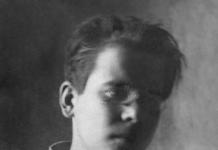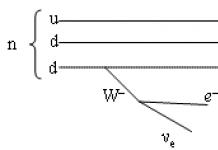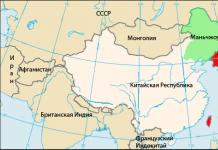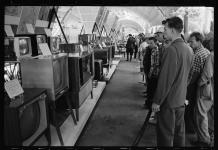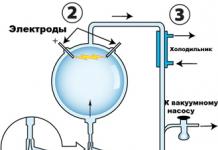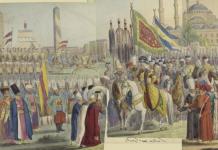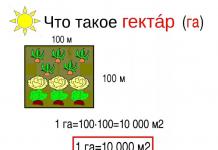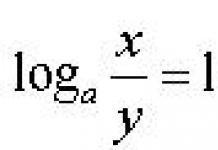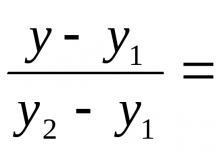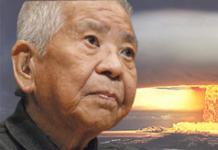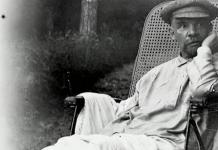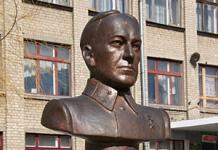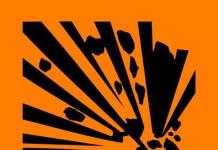... For there is nothing hidden that has not been revealed
would, and a secret that would not be recognized.
(Gospel of Matthew)
I did not imagine and could not imagine that the old archival documents relating to the period of Lenin's illness and death could have such a strong emotional impact. Much can be felt, understood and read between the lines in the witnesses of the past time, withered from time to time. Here is a leaf of a tear-off notebook hastily written in a large, sweeping handwriting by N. A. Semashko. An intellectual of the old formation, close to Lenin, the People's Commissar of Health, who, as K. E. Voroshilov later argued at a meeting of the commission for perpetuating the memory of Lenin, was against the long-term preservation of the body of the deceased leader and who therefore "must be driven out of the commission", this conscientious doctor, taking close to heart his responsibility and, perhaps, feeling even special personal guilt for the sad outcome of the illness of a deeply revered person, tormenting himself for his impotence to save Lenin's life, excitedly asks the pathologist A.I. Abrikosov to pay special attention to the need for strong morphological evidence of Lenin's absence luetic (Lues is a synonym for syphilis) defeats in order to preserve his bright image. But neatly stitched beautiful little books with black calico binding and silver embossing, containing a huge number of urine analyzes and long graphs of the dynamics of its main indicators - analyzes, in principle, are not very necessary and do not clarify anything. But on the other hand, how neat and conscientious is the Kremlin's medical and sanitary service, how beautifully everything is designed!
Various versions (at least 3) of Lenin's autopsy protocols are kept. Written by hand under dictation, they bear numerous traces of edits, searches for the most correct formulations, are dotted with crossed out paragraphs, inserts, etc. It can be seen that it was especially difficult to write the final document, in which the history of the disease, stages of treatment was presented on three pages of small text and the cause of Lenin's death.
There is everything here - both the justifications for the medical actions of doctors, most of them (if we take into account the true diagnosis) dubious and even incorrect, and the alleged success of the treatment that was highlighted. Unfortunately, no blood tests were found in the archives, although it is known that they were done many times. But a thin translucent sheet with the analysis of cerebrospinal fluid, fortunately, survived.
Large folders contain photographs and a detailed description of Lenin's brain. How severely the disease was distorted by the powerful thinking apparatus: dents, scars, cavities occupied the entire left half of the brain.
In cardboard archival folders containing images of the brain and stained sections of various tissues (brain, aorta, blood vessels, kidneys, liver), enclosed in transparent glass, you can still feel the pungent smells of formalin and something elusive, peculiar only to anatomical theaters.
It was impossible, however, not to notice that the overwhelming part of the documents seen for all these many years remained practically out of sight of historians, that they have been unclaimed for more than 70 years. Meanwhile, it is these documents, and only they, that can shed light on one of the most voluntarily or involuntarily confused problems of Lenin's biography - the essence of his illness.
It is hardly reasonable to dismiss the need for full documentary evidence of the true disease, unfoundedly denying all other versions, except for atherosclerosis, likening A. P. Chekhov's learned neighbor, who argued that "this cannot be, because this can never be."
History, like nature, abhors voids and white spots. In the absence of reliable data, they are filled with fiction or lies similar to the truth.
Diagnostic obscurations
As is, unfortunately, often the case with an over-attentive attitude to the patient and the involvement of many authoritative specialists in his treatment at once, an obvious and even "student" diagnosis is surprisingly replaced by some clever, collegially accepted, reasonably substantiated and ultimately erroneous diagnosis.
NA Semashko, of course with the best of intentions, especially during periods of deteriorating health of Lenin, invited many prominent and prominent specialists from Russia and Europe to consultations. Unfortunately, they all confused rather than clarified the essence of Lenin's illness. The patient was consistently given three incorrect diagnoses, according to which he was treated incorrectly: neurasthenia (overwork), chronic lead poisoning and syphilis of the brain.
At the very beginning of the disease at the end of 1921, when fatigue fell heavily on the still strong and strong Lenin, the attending doctors unanimously agreed on the diagnosis - overwork. Very soon, however, it became clear that rest was of little use, and all the excruciating symptoms — headaches, insomnia, decreased performance, etc. — did not stop.
In early 1922, even before the first stroke, a second concept was put forward - chronic lead poisoning from two bullets left in soft tissues after an assassination attempt in 1918. However, they did not exclude the consequences of poisoning from the curare poison, which the bullets allegedly contained.
It was decided to remove one of the bullets (operation on April 23, 1922), which, as you know, also did not have any positive effect on Lenin's deteriorating health. It was then, probably, that the hypothesis arose about syphilis as the basis of Lenin's brain damage. Now it is difficult to say who put forward such a version, which went on like a red thread through Lenin's entire painful dying path and was never revised during his lifetime.
In archival documents and open literature, almost all participants in those distant consultations argue that they were just against such a diagnosis, even then they assumed that Lenin's cerebral vascular lesions were of an atherosclerotic nature. O. Foerster, who had been observing Lenin almost constantly since 1922, immediately after the March episode with the alleged "food" poisoning claimed that he had already diagnosed "softened cerebral thrombosis" (of the brain. Yu. L.). G. Klemperer, who had been observing Lenin together with Foerster for quite a long time, agreed with this diagnosis.
In June 1922, in an official report, according to Klemperer, he said in connection with the operation to remove the bullet: in his opinion, Lenin had atherosclerotic cerebral hemorrhage and this disease had no connection with the bullet. And fifteen years after Lenin's death, in 1939, Klemperer would definitely write: "The possibility of a venereal disease was ruled out." But Lenin was treated with anti-lyuetic means: injections of arsenic preparations, iodide compounds, etc.!
In connection with a sharp deterioration in Lenin's health after another stroke in March 1923, the following came to Moscow: A. Strumpel, a 70-year-old patriarch-neuropathologist from Germany, one of the leading specialists in spinal cord and spastic paralysis; S. E. Genshen - brain diseases specialist from Sweden; O. Minkovsky - famous diabetologist; O. Bumke - psychiatrist; Professor M. Nonne is a prominent specialist in the field of neuroluces (all from Germany).
An international council with the participation of the aforementioned persons, together with Foerster, who had previously arrived in Moscow, as well as Semashko, Kramer, Kozhevnikov, and others, did not reject the syphilitic genesis of Lenin's disease.
After examining Lenin, on March 21, Professor Strumpel diagnoses: endarteriitis luetica (syphilitic inflammation of the inner lining of the arteries - endarteritis) with secondary softening of the brain. And although syphilis has not been confirmed in the laboratory (the Wasserman reaction of blood and cerebrospinal fluid is negative), he categorically states: "Therapy should only be specific (that is, antiluetic)."
The entire medical Areopagus agreed with this.
Lenin began to vigorously carry out specific treatment. After his death, when the diagnosis was clear, when describing the entire history of the disease, this anti-syphilitic treatment finds a kind of justification: "Doctors identified the disease as a consequence of a widespread, but part of a local vascular process in the brain (sclerosis vasorum cerebri) and assumed the possibility of its specific origin ( whatever - "assumed", they were in a hypnotic delusion. Yu. L.), as a result, attempts were made to carefully use arsenobenzene and iodide preparations. "Further, separated by a comma, there is an exculpatory excuse insert, written on the left in the margins:" so as not to miss this measure in case such an assumption was confirmed. "And then a completely major continuation : "During this treatment, there was a very significant improvement to the degree of disappearance of painful symptoms, general and local, and the headaches stopped after the first infusion."
The cautious doctors (Guetier, Foerster, Kramer, Kozhevnikov, etc.), of course, were cunning - an improvement did come, but in any case without any connection with the introduction of anti-lyuetic drugs.
Moreover, they further write: "On March 10, complete paralysis of the right limb with symptoms of deep aphasia occurred, this state took a persistent and prolonged course. Taking into account the severity of the symptoms, it was decided to resort to mercury treatment in the form of rubbing and Bismugenal" it was necessary to stop very soon (after three rubbing), due to pneumonia found in the patient "or, as V. Kramer wrote," idiosyncrasy, that is, intolerance. "
It should be noted that Lenin was also intolerant to German doctors. He intuitively understood that they harm him rather than help. "For a Russian person," he confessed to Kozhevnikov, "German doctors are unbearable."
Were there really any arguments in favor of neurosyphilis? There were no direct or definite signs of syphilis. The Wasserman reaction of blood and cerebrospinal fluid, delivered more than once, was negative.
Of course, one could assume congenital syphilis, so widespread at the end of the last - the beginning of this century in Russia. (According to Kuznetsov (cited by L. I. Kartamyshev), in 1861-1869 more than 60 thousand people fell ill with syphilis in Russia annually, and in 1913 in Moscow there were 206 syphilitics for every 10 thousand people.) But this is also an assumption. is obviously wrong, if only because all of Lenin's brothers and sisters were born on time and were healthy. And there was no reason at all to believe that Lenin could have contracted syphilis from casual relationships, which he, no doubt, never had.
What, then, was the basis for the hypothesis of neuroluset?
Most likely, the logic of clinicians at the end of the last - the beginning of this century worked: if the etiology is unclear, the picture of the disease is not typical - look for syphilis: it is many-sided and diverse. "From the early period of the disease," wrote F. Henschen in 1978, "there was a dispute about the causes of vascular lesions - syphilis, epilepsy or poisoning."
As for epilepsy, more precisely, small seizures observed during Lenin's disease, they were the result of focal irritation of the cerebral cortex by the adhesive process during scarring of the zones of necrosis (ischemia) of different parts of the brain, which was confirmed by autopsy.
Another probable diagnosis - atherosclerosis of the cerebral vessels - also had no absolute clinical signs and was not seriously discussed during Lenin's illness. There were several compelling arguments against atherosclerosis. First, the patient had no symptoms of ischemia (circulatory disorders) of other organs, so characteristic of generalized atherosclerosis. Lenin did not complain of pain in his heart, liked to walk a lot, did not experience pain in the limbs with the characteristic intermittent claudication. In a word, he did not have angina pectoris, and there were no signs of vascular lesions in the lower extremities.
Secondly, the course of the disease was atypical for atherosclerosis - episodes with a sharp deterioration in the condition, paresis and paralysis ended with an almost complete and rather rapid recovery of all functions, which was observed at least until mid-1923. Of course, the preservation of the intellect, which usually suffers greatly after the first stroke, was also surprising. Other possible diseases - Alzheimer's disease, Pick's, or multiple sclerosis - figured in one way or another in medical discussions, but were unanimously rejected.
Was there any reason to treat Lenin with anti-lyuetic means with such a shaky diagnosis?
In medicine, there are situations when treatment is carried out at random, blindly, with an incomprehensible or unsolved cause of the disease, the so-called treatment - ex juvantibus. In the case of Lenin, this is most likely the case. In principle, the diagnosis of luetic vascular disease and appropriate treatment did not affect the course of atherosclerosis and did not affect the predetermined outcome. In a word, it did not bring physical harm to Lenin (apart from the painfulness of the procedures). But the false diagnosis - Neurolues - very quickly became an instrument of political insinuations and, of course, caused considerable moral damage to Lenin's personality.
Autopsy. Temporary embalmingOn the night after Lenin's death, January 22, 1924, a commission was created to organize the funeral. It included F.E.Dzerzhinsky (chairman), V.M.Molotov, K.E. Voroshilov, V.D.Bonch-Bruevich and others. The commission made several urgent decisions: it instructed the sculptor S. D. Merkurov to immediately remove the plaster mask from Lenin's face and hands (which was done at 4 a.m.), invite the famous Moscow pathologist A. I. Abrikosov for temporary embalming (for 3 days before the funeral ) and perform an autopsy of the body. It was decided to place the coffin with the body in the Column Hall for farewell, followed by burial on Red Square.
For temporary embalming ("freezing"), a standard solution was taken, consisting of formalin (30 parts), zinc chloride (10 parts), alcohol (20 parts), glycerin (20 parts) and water (100 parts). A routine incision of the rib cage was made along the cartilage of the ribs and the sternum was temporarily removed. A preservative fluid was injected through the opening in the ascending aorta using a large "Zhanet" -type syringe. “When filling,” N. A. Semashko, who was present during the autopsy, recalled on January 29, 1924, “they drew attention to the fact that the temporal arteries are not contoured and that on the lower part of the auricle (apparently, the right one? - Yu. L.) dark spots are formed. After filling with liquid, these spots began to dissolve, and when the tips of the ears were rubbed with fingers, they turned pink and the whole face got a completely fresh look. ”Thus, there were all the signs of a successful soaking of the tissues of the head and body with the embalming solution and good preservation of the vascular system. immediately after the introduction of the solution, an autopsy had to be performed, which entailed the inevitable leakage of the solution from the tissues.
The autopsy report reads: "Elderly man, correct physique, satisfactory nutrition. On the skin of the anterior end of the right clavicle there is a linear scar 2 cm long. On the outer surface of the left shoulder there is another scar of irregular shape, 2 x 1 cm (first bullet mark). On the skin back at the angle of the left scapula - a roundish scar 1 cm (trace of the second bullet) .A callus is felt on the border of the lower and middle part of the humerus. Above this place on the shoulder, the first bullet surrounded by a connective tissue membrane is felt in the soft tissues. Skull - after opening - The dura mater is thickened along the longitudinal sinus, dull, pale. In the left temporal and partly frontal region there is yellow pigmentation. The anterior part of the left hemisphere, compared to the right, is somewhat sunken. Fusion of the soft and dura mater near the left Sylvian sulcus. The brain - without the meninges - weighs 1340 g. In the left hemisphere, in the region of the precentral convolutions, parietal and atrial lobes, paracentral fissures and temporal gyri are areas of strong retraction of the brain surface. The pia mater in these places is cloudy, whitish, with a yellowish tinge.
Vessels of the base of the brain. Both vertebral arteries do not collapse, their walls are dense, the lumen on the cut is sharply narrowed (gap). The same changes in the posterior cerebral arteries. The internal carotid arteries, as well as the anterior cerebral arteries, are dense, with uneven thickening of the walls; their lumen is significantly narrowed. The left internal carotid artery in its intracranial part does not have a lumen and on the cut it appears in the form of a solid, dense, whitish cord. The left Sylvian artery is very thin, hardened, but retains a small slit-like lumen in the cut. When the brain is cut, its ventricles are dilated, especially the left one, and contain fluid. In places of depressions - softening of brain tissue with many cystic cavities. Foci of fresh hemorrhage in the area of the choroid plexus covering the quadruple.
Internal organs. There are adhesions of the pleural cavities. The heart is enlarged, there is a thickening of the semilunar and bicuspid valves. The ascending aorta has a small number of bulging yellowish plaques. The coronary arteries are strongly compacted, their lumen gapes, clearly narrowed. On the inner surface of the descending aorta, as well as the larger arteries of the abdominal cavity, there are numerous, strongly protruding yellowish plaques, some of which are ulcerated and petrified.
Lungs. In the upper part of the left lung there is a scar that penetrates 1 cm into the depth of the lung. Above, fibrous thickening of the pleura.
Spleen, liver, intestines, pancreas, organs of internal secretion, kidneys without visible features.
Anatomical diagnosis. Widespread atherosclerosis of the arteries with pronounced damage to the arteries of the brain. Atherosclerosis of the descending part of the aorta. Hypertrophy of the left ventricle of the heart, multiple foci of yellow softening (due to vascular sclerosis) in the left hemisphere of the brain during the period of resorption and transformation into cysts. Fresh hemorrhage in the choroid plexus of the brain over the quadruple. Callus of the humerus.
Encapsulated soft tissue bullet in the upper left shoulder.
Conclusion. The basis of the deceased's illness is widespread atherosclerosis of blood vessels due to their premature wear (Abnutzungssclerose). As a result of the narrowing of the lumen of the arteries of the brain and a violation of its nutrition from insufficient blood flow, focal softening of the brain tissue occurred, explaining all the preceding symptoms of the disease (paralysis, speech disorders). The immediate cause of death was: 1) increased circulatory disorders in the brain; 2) hemorrhage in the pia mater in the quadruple region ".
The autopsy began at 11:10 a.m. and finished at 3:50 p.m. on January 22, 1924.
And here are the results of microscopic analysis carried out by A. I. Abrikosov: "There is a thickening of the inner membranes in the places of atherosclerotic plaques. Lipoids related to cholesterol compounds are everywhere. In many accumulations of plaques, there are cholesterol crystals, calcareous layers, petrification.
The middle muscular membrane of the vessels is atrophic, sclerotic in the inner layers. The outer shell is unchanged.
Brain. Focuses of softening (cysts), resorption of dead tissue, so-called granular balls, deposits of blood pigment grains are also noticeable. Glia compaction is small.
Good development of pyramidal cells in the frontal lobe of the right hemisphere, normal appearance, size, nuclei, processes.
Correct ratio of cell layers on the right. Absence of changes in myelin fibers, neuroglia and intracerebral vessels (right).
Left hemisphere - proliferation of the pia mater, edema.
Conclusion. February 16, 1924. Atherosclerosis is a wear sclerosis. Changes in the blood vessels of the heart, malnutrition of the organ ".
“Thus,” writes A. I. Abrikosov, “microscopic examination confirmed the autopsy data, establishing that the only basis for all changes is atherosclerosis of the arterial system with a predominant lesion of the cerebral arteries. There is no indication of the specific nature of the process (syphilis, etc.) the vascular system, nor in other organs was found. "
It is curious that the experts, which included Foerster, Osipov, Deshin, Rozanov, Weisbrod, Bunak, Getye, Elistratov, Obukh and Semashko, found an unusual, but apparently quite appropriate term in this case, defining the features of the vascular pathology of Lenin's brain, - Abnutzungssclerose, that is, sclerosis from wear.
AtherosclerosisOn the third day after the death of Lenin, January 24, 1924, N.A. Semashko, concerned about rumors spreading in Russia and abroad about the allegedly syphilitic nature of the deceased's disease, as well as the relatively meager evidence of atherosclerosis given in the autopsy report, wrote, apparently, according to to the authorities: "They all (including Weisbrod) consider it more appropriate to mention the explanation about the absence of any indications of a syphilitic lesion in the protocol of the microscopic examination, which is now being prepared. N. Semashko. 24.1".
It should be noted that the autopsy of Lenin's body was carried out on January 22 in unusual conditions "on the second floor of a house in a room with a terrace facing west. The body of Vladimir Ilyich was lying on two oilcloth tables compiled next to each other" (note to the autopsy act) ... Since it was supposed to preserve the body for a short time and prepare it for inspection, some simplifications were made during autopsy. No incision was made in the neck, and thus the carotid and vertebral arteries were not exposed, examined and taken for microscopic examination. For microscopic analysis, pieces of the brain, kidneys and walls of only the abdominal aorta were taken.
As it turned out later, this severely limited the anti-syphilitic arguments of microscopic analysis.
So, what should be distinguished from the autopsy report?
First, the presence of numerous foci of necrosis of brain tissue, mainly in the left hemisphere. On its surface, 6 zones of retraction (dips) of the cerebral cortex were noticeable. One of them was located in the parietal region and encompassed large convolutions that bound the deep central groove in front and behind, extending from the vertex downward. These grooves are responsible for the sensory and motor functions of the entire right half of the body, and the higher the focus of necrosis of the brain tissue is located to the crown, the lower the movement and sensitivity disorders are observed on the body (foot, lower leg, thigh, etc.). The second zone refers to the frontal lobe of the brain, which is known to be related to the intellectual sphere. The third zone was located in the temporal lobes and the fourth in the occipital lobes.
Outside, the cerebral cortex in all these areas, and especially in the area of the central sulcus, was soldered with coarse scars with the membranes of the brain, deeper, there were voids filled with fluid (cysts), formed as a result of the resorption of dead medulla.
The left hemisphere has lost at least a third of its mass. The right hemisphere was slightly affected.
The total weight of the brain did not exceed the average figures (1340 g), but taking into account the loss of matter in the left hemisphere, it should be considered quite large. (However, the weight, as well as the size of the brain and its individual parts, are in principle insignificant. The largest brain was in I. Turgenev - more than 2 kg, and the smallest - in A. Frans - just over 1 kg).
These findings fully explain the picture of the disease: right-sided paralysis without involvement of the muscles of the neck and face, difficulties with counting (addition, multiplication), which indicates the loss of primarily non-professional skills.
The intellectual sphere, connected most of all with the frontal lobes, was quite intact even in the final stage of the disease. When the doctors suggested to Lenin to play checkers as a distraction (or calming) means, and even with a weak opponent, he remarked irritably: "What are they, what a fool do they think I am?"
The fusion of the cerebral cortex with the membranes, especially pronounced in the region of the central convolutions, undoubtedly caused those frequent episodes of short-term convulsive seizures that so worried the patient Lenin.
Has there been anything from a study of the brain to determine the original cause of its damage? First of all, we note that no typical syphilitic changes such as gummas, special tumor-like growths characteristic of tertiary syphilis were found. Granular balls were found in the circumference of the cystic cavities - the result of the activity of phagocytes - cells that absorb hemoglobin and dead tissue.
The diagnosis of Strumpel is not confirmed - luetic endarteritis. The lumen of the arteries of the brain extending from the circle of Willis was indeed narrowed, but it is almost impossible to determine what caused this - infection or atherosclerosis by the morphological picture. Most likely, we can talk about poor filling of these vessels due to narrowing or blockage of the left internal carotid artery. Well-known pathologists - A. I. Strukov, A. P. Avtsyn, N. N. Bogolepov, who have repeatedly examined preparations of Lenin's brain, categorically deny the presence of any morphological signs of a specific (luetic) lesion.
Further, the blood vessels of the brain itself were examined after it was removed from the cranium. Apparently, it was possible to see from the cranial cavity the cut left internal carotid artery, which turned out to be completely obliterated (occluded). The right carotid artery also looked affected with a slightly narrowed lumen.
Note that a large mass of the brain is supplied with blood only through four vessels, of which two large internal carotid arteries supply the anterior two-thirds of the brain, and two relatively thin vertebral arteries irrigate the cerebellum and occipital lobes of the brain (posterior third of the brain).
One of the measures created by intelligent nature that reduces the risk of immediate death from blockage or damage to one - two or even three of the above arteries is to connect all four arteries to each other at the base of the brain in the form of a continuous vascular ring - the circle of Willis. And from this circle there are arterial branches - forward, to the middle and back. All large arterial branches of the brain are located in the cracks between the numerous convolutions and give up small vessels from the surface to the depths of the brain.
Brain cells, I must say, are unusually sensitive to exsanguination and die irreversibly after a five-minute cessation of blood supply.
And if Lenin's left internal carotid artery was most affected, then the blood supply to the left hemisphere was due to the right carotid artery through the circle of Willis. It was, of course, incomplete. Moreover, the left hemisphere "robbed" the blood supply and the healthy right hemisphere. The autopsy report indicates that the lumen of the main artery (a. Basilaris), which is formed from the fusion of both vertebral arteries, as well as all six cerebral arteries proper (anterior, middle and posterior), was narrowed.
Even a short-term spasm of cerebral vessels, not to mention thrombosis or rupture of the walls, with such deeply penetrated lesions of the main arteries feeding the brain, of course, led either to short-term paresis of the limbs and speech defects, or to persistent paralysis, which was observed in the final stage of the disease.
One can only regret that the vessels on the neck, the so-called extracranial vessels, were not examined: the common external and internal carotid arteries, as well as the vertebral arteries extending from the large thyroid-cervical trunks. It is now well known that it is here, in these vessels, that the main tragedy is played out - their atherosclerotic lesion, leading to a gradual narrowing of the lumens due to the development of plaques protruding into the lumen and thickening of the vascular membranes until they are completely closed.
At the time of Lenin, this form of brain disease (the so-called extracranial pathology) was essentially unknown. In the 1920s, there were no diagnostic tools for such diseases - angiography, various types of encephalography, determination of the volumetric blood flow rate using ultrasound studies, etc. There were no effective treatments either: angioplasty, vascular bypass bypassing the narrowed space, and many others.
Typical atherosclerotic plaques were found during autopsy of Lenin's body in the walls of the abdominal aorta. The vessels of the heart were changed slightly, as were the vessels of all internal organs.
Here is how O. Foerster reported on February 7, 1924 in a letter to his colleague O. Witke about the origin of Lenin's disease: “Autopsy showed total obliteration of the left internal carotid artery, the entire a. Basilaris. Right a. Carotis int. - with severe calcification. The left hemisphere was behind by a small exception, it is totally destroyed - the right one has changes. Severe aortitis abdominalae, mild coronary sclerosis " (Kuhlendaahl. Der Patient Lenin, 1974).
H. A. Semashko in his article "What did the autopsy of Vladimir Ilyich's body gave?" that its walls did not collapse during a transverse cut, significantly closed the lumen, and in some places were so saturated with lime that they hit them with tweezers as if they were on a bone. "
As for syphilis, neither a postmortem examination nor a microscopic analysis of tissue pieces taken for examination revealed any changes specific to this disease. There were no characteristic gummy formations in the brain, muscles or internal organs, and there were no typical changes in large vessels with damage mainly to the middle membrane. Of course, it would be extremely important to study the aortic arch, which is affected in the first place in syphilis. But, apparently, the pathologists were so confident in the diagnosis of advanced atherosclerosis that they considered it unnecessary to conduct such research.
The attending physicians, as well as subsequent researchers, were most struck by the inconsistency of the course of Lenin's disease with the usual course of atherosclerosis of the cerebral vessels described in the medical literature. Once the defects that came on quickly disappeared, and did not become heavier, as is usually the case, the disease went on in some waves, and not along an inclined one, as usual. On this occasion, several original hypotheses were created.
Perhaps it is most reasonable to agree with the opinion of V. Kramer, which was also shared by A. M. Kozhevnikov.
In March 1924, in the article "My memories of V. I. Ulyanov-Lenin," he writes: "What explains the peculiarity, unusual for the usual picture of general cerebral atherosclerosis, the course of Vladimir Ilyich's disease? There can be only one answer - among outstanding people, like says the belief that has taken root in the minds of doctors, everything is unusual: both life and illness always flow with them differently from other mortals. "
Well, the explanation is far from scientific, but humanly quite understandable.
I believe that what has been said is enough to draw a definite and clear conclusion: Lenin had a severe lesion of the cerebral vessels, especially the system of the left carotid artery. However, the reason for such an unusual prevailing unilateral lesion of the left carotid artery remains unclear.
Lenin's brain
Soon after Lenin's death, the Russian government decided to create a special scientific institute for the study of Lenin's brain (Scientific Research Institute of the Brain of the Russian Academy of Medical Sciences).
It seemed important and quite probable to Lenin's companions to discover those structural features of the leader's brain that determined his extraordinary abilities. The largest neuromorphologists of Russia were involved in the study of Lenin's brain: G. I. Rossolimo, S. A. Sarkisov, A. I. Abrikosov and others. The famous scientist Vocht and his assistants were invited from Germany.
Anthropologist V.V.Bunak and anatomist A.A.Deshin thoroughly described the external structure of the brain: features of the location and size of grooves, convolutions and lobes. The only thing that can be learned from this scrupulous description is the idea of a well-formed cerebral cortex (of course, the right healthy hemisphere) without any noticeable deviations from the norm.
Great hopes for identifying something unusual were pinned on the study of the cytoarchitectonics of Lenin's brain, in other words, on the study of the number of brain cells, their layered arrangement, the size of cells, their processes, etc.
Among the many different findings, which, however, do not have a strict functional assessment, the well-developed third and fifth (Betz cells) cell layers should be noted. Perhaps this strong expression is associated with the unusual properties of Lenin's brain. However, this could be the result of their compensatory development instead of the loss of a part of the neurons of the left hemisphere.
Considering the limited possibilities of the morphology of his time, it was decided to dissect Lenin's brain into thin sections, enclosing them between two glasses. There were about two thousand such sections, and they have been resting for more than 70 years in the storage of the Institute of the Brain, awaiting new methods and new researchers.
However, it is probably difficult to expect any special results from morphological studies in the future.
The brain is a unique and unusual organ. Created from fat-like substances, compactly packed into a closed bone cavity, connected to the outside world only through the eye, ear, nose and skin, it defines the whole essence of its carrier: memory, abilities, emotions, unique moral and psychological traits.
But the most paradoxical thing is that the brain - storing colossal volume of information, being the most perfect apparatus for its processing - being dead, already nothing significant can tell researchers about its functional characteristics (at least at the present stage): just like by the location and number of elements of a modern computer, it is impossible to determine what it is capable of, what its memory is, what programs are embedded in it, what is its speed.
The brain of a genius can be the same in structure as the brain of an ordinary person. However, the staff of the Institute of the Brain, engaged in the cytoarchitectonics of Lenin's brain, believe that this is not at all true or not at all true.
Fanny Kaplan's fatal bulletLenin's injury, which happened at the Mikhelson plant on August 30, 1918, in the end played an almost decisive role in Lenin's illness and death.
Fanny Kaplan fired at Lenin from a distance of no more than three meters with a Browning pistol with medium-caliber bullets. Judging by the reproduced picture of the investigative experiment conducted by Kingisepp, at the moment of the shots Lenin was talking to Popova, turning his left side to the killer. One of the bullets hit the upper third of the left shoulder and, destroying the humerus, stuck in the soft tissues of the shoulder girdle. The other, entering the left shoulder girdle, caught the spine of the scapula and, piercing the neck through and through, came out from the opposite right side under the skin near the junction of the clavicle with the sternum.
On the roentgenogram made by DT Budinov (resident of the Catherine Hospital) on September 1, 1918, the position of both bullets is clearly visible.
What was the destructive course of the bullet from the entrance hole on the back surface of the shoulder girdle to the edge of the right sternocleidomastoid muscle?
Having passed through the layer of soft tissues, the bullet with the serrated head already split from the impact into the spine of the scapula passed through the apex of the left lung, protruding 3-4 cm above the clavicle, tearing the pleura covering it and damaging the lung tissue to a depth of about 2 cm. In this part of the neck (the so-called scalene-vertebral triangle) there is a dense network of blood vessels (thyroid-cervical trunk, deep neck artery, vertebral arteries, venous plexus), but most importantly, the main artery that feeds the brain passes here: the common carotid artery together with the thick jugular vein, vagus and sympathetic nerves.
The bullet could not but destroy the dense network of arteries and veins in this area and somehow damage or bruise (contusion) the wall of the carotid artery. Immediately after the wound, blood flowed out plentifully from the wound on the back, which in the depths of the wound also entered the pleural cavity, soon filling it completely. "A huge hemorrhage in the left pleural cavity, which displaced the heart so far to the right," - VN Rozanov recalled in 1924.
Further, the bullet slipped behind the throat and, colliding with the spine, changed its direction, penetrating the right side of the neck into the region of the inner end of the collarbone. Here a subcutaneous hematoma (accumulation of blood in adipose tissue) has formed.
Despite the severity of the injury, Lenin quickly recovered and, after a short rest, began active work.
However, after a year and a half, phenomena associated with insufficient blood supply to the brain appeared: headaches, insomnia, partial loss of working capacity.
Removing the bullet from the neck in 1922, as we know, did not bring relief. We emphasize that, according to the observation of V.N.Rozanov, who participated in the operation, Lenin had no signs of atherosclerosis at that time. “I don’t remember that then we noted anything special in the sense of sclerosis, the sclerosis was according to age,” Rozanov recalled.
All further events clearly fit into the picture of gradual narrowing of the left carotid artery, which is associated with resorption and scarring of the tissues around it. Along with this, it is obvious that in the left carotid artery, injured by a bullet, the process of formation of an intravascular thrombus, firmly adhered to the inner membrane in the area of the primary contusion of the arterial wall, began. A gradual increase in the size of a thrombus may be asymptomatic until it blocks the lumen of the vessel by 80 percent, which, most likely, happened by the beginning of 1921.
The further course of the disease with periods of improvement and deterioration is typical for this kind of complications.
It can be assumed that atherosclerosis, which undoubtedly was by this time in Lenin, most of all struck the locus minoris resistentia, that is, the most vulnerable spot - the injured left carotid artery.
The point of view of one of the well-known Russian neuropathologists, Z. L. Lurie, agrees with the stated concept.
"Neither clinical studies," he writes in the article "Lenin's Disease in the Light of Modern Teaching on the Pathology of Cerebral Circulation," "Neither autopsy found significant signs of atherosclerosis or any other pathologies on the part of internal organs." Therefore, Lurie believes that Lenin "had a narrowed left carotid artery not due to atherosclerosis, but because of the scars that tightened it, left by a bullet that passed through the neck tissue near the carotid artery during an attempt on his life in 1918".
So the bullet directed by the killer Kaplan at Lenin eventually reached its goal.
Instructions
Lenin began to feel unwell in 1921. It was at this time that he began to experience frequent severe headaches and fatigue. He began to experience unexplained bouts of nervous excitement. During these attacks, the politician carried all nonsense and waved his arms. Also, Lenin's limbs begin to go numb, up to complete paralysis. Doctors for the leader of the proletariat are summoned from Germany. But neither domestic doctors, nor foreign doctors can give him an accurate diagnosis.
By the end of 1933, his condition deteriorated sharply. At times he can no longer speak articulately. In the spring of 1923, Lenin was transported to Gorki. In the last lifetime photographs, Vladimir Ilyich looks simply terrifying: he is strong, and his eyes are simply insane. He is constantly tormented by nightmares, he often screams. At the beginning of 1924, Lenin is getting a little better. On January 21, the doctors who examined him did not reveal any alarming symptoms in Ilyich, however, by the evening he suddenly became ill and died.
Many possible diagnoses were put forward after death. Doctors talked about epilepsy, Alzheimer's disease, multiple sclerosis, and lead poisoning. In 1918, an attempt was made on Lenin's life, and one of the two bullets that hit him was removed after his death. Allegedly, the bullet passed close to the vital arteries, and caused the premature sclerosis of the carotid artery.
However, ordinary vascular sclerosis has completely different symptoms. During his lifetime, Lenin's illness was more like syphilis. By the way, some of the doctors who were invited to treat the leader specialized in syphilis. However, some facts do not fit into this version either. The doctors who performed the autopsy did not find any symptoms of syphilis. True, it was unacceptable to make public the fact that the leader died of a venereal disease. This would be a shadow on the "bright image of Ilyich."
More recently, the American scientist Harry Winters and the St. Petersburg historian Lev Lurie proposed a new version of Lenin at a medical conference at the University of Maryland. Poor heredity was cited as the main reason. Ilyich's father also died at a fairly early age. Perhaps the predisposition to hardening of the arteries was inherited by Lenin. Stress is one of the most important factors that can cause a stroke, and there were a lot of worries and worries in Lenin's life.
Lev Lurie suggested that Lenin could have been poisoned by Joseph Vissarionovich Stalin. Winters, having studied the autopsy results and the history of Lenin's illness, noted that toxicological tests that could detect traces of poisons in the leader's body were not carried out. Poisoning is just one of the many versions of the cause of death of V.I. Lenin.
Vladimir Ilyich Lenin died on January 21, 1924 at the age of 53. The cause of death was a cerebral hemorrhage. Before that, he was ill, and from May 1923 he lived in Gorki, without appearing in Moscow. After his death, it was decided not to bury or cremate his body, but to embalm and place it in a mausoleum.
The true cause of Lenin's death is hidden in the fog of history, and, probably, will forever remain completely unclear. The official autopsy report speaks of a cerebral hemorrhage, but what was the impetus for the rapid extinction remains a mystery.
Date of death
The death of the leader of the world proletariat occurred on January 21, 1924 in Gorki. Vladimir Ilyich Lenin died in the evening, at 18:50, at the age of 53, from an illness, the appearance of which is still a mystery.
The assassination attempt of 1918
This year was "rich" for Ilyich in assassination attempts. The first happened on January 1, when a group of malefactors shot the car of the Bolshevik leader. Lenin was not injured in the incident.
The second, which became more dangerous, happened on August 30, 1918. Fanny Kaplan, a 28-year-old Socialist-Revolutionary, who waited for the end of the next meeting, fired a pistol at him several times and hit him twice. In the resulting commotion, the terrorist was initially missed. She betrayed herself, strange, most likely from excitement, behavior.
One bullet hit the arm, the second hit the upper part of the left lung, causing internal bleeding. Lenin lost consciousness and was taken away. After treatment, he quickly recovered and at the end of September started to work.
Initially, Kaplan dropped the charges, but unexpectedly confessed, taking the entire burden of responsibility upon herself. She did not betray any of the accomplices (if there were any), claiming that she acted independently. Executed on September 3, 1918.
Decline in health in May 1922

The photograph taken by Vladimir Ilyich's sister depicts a thinner man with a wild face and crazy eyes. This is how I. Zbarsky characterizes the photograph, who took part in the embalming of the leader's body.
The first symptom of serious problems was general malaise. Ilyich planned to go on vacation with his wife to a cozy place not far from Yekaterinburg, but he did not succeed in carrying out his plan. Exacerbated bouts of heartburn, weakness in the right hand, vomiting became the harbingers of global changes in health. As a result, from June to October 1922, Lenin could not engage in political activities. At this time, Vladimir Ilyich complains of frequent headaches and rapid fatigue.
After a while, periodic numbness of the fingers and toes, similar to paralysis, and incomprehensible bouts of intense excitement, as a result of which Lenin waving his arms and talking nonsense, are added.
Moving to Gorki
Due to an unknown disease and the lack of possible ways to resist its development, Vladimir Ilyich is transported to Gorki. In fact, he is sent to die, this happens in the spring of 1923.
Here he is under the care of his family and doctors who are powerless to help. At the beginning of January 1924, Lenin completely ceases to talk, during his sleep he is tormented by nightmares.
On the morning of January 21, there is a slight relief, accompanied by lethargy. The examination, carried out by Professors Osipov and Förster, does not reveal anything suspicious.
However, the rapid changes began in the evening, on the same day:
- 18:00 the pulse increases sharply, convulsions appear;
- after 30 minutes, the body temperature rises to 42.5 ℃;
- 18:50 the doctors present ascertain the death of the leader.
Official conclusion on the causes of death
The official conclusion on the death of V.I.Ulyanov-Lenin contains such information. The reason is widespread atherosclerosis of blood vessels due to premature wear. As a result, there was a narrowing of the lumen of the artery of the brain and malnutrition due to insufficient blood flow. Thus, death came:
- from circulatory disorders;
- profuse hemorrhage in the pia mater in the quadruple region.
Why did atherosclerosis develop? There are at least two versions here.
The first is a hereditary predisposition received from a father who died at the age of 55 from a cerebral hemorrhage.
The second is the consequences of an unsuccessful assassination attempt, as a result of which the bullet knocked off a piece of the scapula, touched the lung and passed next to the vital arteries. This could well provoke the development of premature sclerosis of the carotid artery.
According to the version that came from abroad, Ilyich's death occurred as a result of syphilis. Endartitis luetica (neurosyphilis) is a disease that affects brain cells. It is based on the only phrase of the Soviet scientist IP Pavlov: "... the revolution was made by a madman with brain syphilis."
The reactions of the authorities and the population
The whole country greeted with bitterness the news of the death of the leader of the world proletariat. People came from distant provinces to see him off on his last journey. It is known that in 3 full days, when Ilyich's body was in the House of Unions, more than one million people came to say goodbye to him.
Funeral

On January 23, Ilyich's body in a red coffin is delivered to Moscow in a baggage car. The farewell ceremony began at 19:00, which took place in the Column Hall of the House of Unions. The embalmed body was kept here for 4 days.
On January 27, the so-called burial was made in a specially built temporary structure, a wooden Mausoleum. In the spring of the same year, it was renovated, and in 1930 a stone structure was erected on this site, which has survived to this day.
Body preservation idea

Initially, the abandonment of Christian funerals in favor of embalming was seen as a kind of "proposal of comrades from the provinces." Officially, it was announced by M.I.Kalinin during the life of the leader, at a meeting of the Politburo in 1923.
Most of those present responded against this, voicing the proposal "priest", "madness" and refusal to "exalt the dust." However, at the repeated meeting, which met after the death of Vladimir Ilyich, no negative statements were made.
Partially preserved historical chronicles accompanying this decision lead to the following conclusions:
- The idea to preserve the body of the "leader of all nations" in the sarcophagus sounded in numerous letters and telegrams sent to the Politburo by workers and peasants. This opinion is shared by the history of the times of the Soviet Union.
- Post-Soviet assumptions look different. JV Stalin could have acted as the initiator, trying to create a so-called counterbalance to Orthodoxy in the form of a "holy image for worship." It was based on the philosophical trend of Russian Marxism, called "God-building".
- Another point of view, the assumption of L. Krasin, confident in the physical immortality of the body and the possibility of physical resurrection of the deceased in the future.
- The latter option implies the fear of the power of the appearance of the leader's twins.
The changes introduced by V.I.Lenin in the life of the world community are obvious. Even researchers who have a negative attitude towards the communist direction are of the same opinion. The leader of the world proletariat is undoubtedly a significant revolutionary figure in world history. And who he was - an evil genius or a light - everyone decides for himself.
Video
"The Death of Lenin", documentary project by Leonid Mlechin, premiere of the TVC channel
Probably, the life of any famous person is shrouded in a kind of aura of mystery and enigma. The details of his life and death arouse genuine interest among the people. The life of the leader of the proletariat, the creator of a new state on the map of the world, Vladimir Ilyich Lenin, is no exception. Until now, scientists argue about some of the details of his life and work, and the circumstances of his death do look a little mysterious. We will talk about this.
What preceded the death of Lenin?
Of course, such a significant political figure as Vladimir Ilyich had both admirers and detractors. There were many of the latter, especially after Lenin became the head of state and began to pursue his policy, which was different from the opinions of other party members. Of course, one should not forget about the people who enthusiastically met the changes in the life of the country, but over time their ardor faded a little. People gathered in secret circles, where they discussed the possibility of physically eliminating the leader. There was also a direct executor - an anarchist revolutionary.
On August 30, 1918, Lenin was supposed to speak at a meeting of workers at an electromechanical plant. Kaplan fired three shots - one was past, two hit the target - Lenin was wounded in the neck and jaw. The 28-year-old woman was detained almost immediately. During interrogation, Fanny did not deny and confessed that it was she who shot Lenin. During the search, they found a Browning with the license plate 150489. From whom she received this weapon, the woman did not confess and replied that the attempt was entirely her own initiative and the investigators would not receive other details.
Kaplan was executed on September 3 of the same year - she was shot without due trial (here, willy-nilly, one can draw a parallel with a few months earlier).
Whether Fanny really acted alone, or whether she was guided by someone more important, we will never know. Much more important is the result - it was after this assassination attempt that Ilyich's health deteriorated.
The last six years of life
Some readers may ask a quite reasonable question - if the leader's health weakened after two rather serious wounds (in the neck and jaw), then how did he last for another six years? Why didn't he die immediately or soon? Scientists dealing with this issue suggest that the destruction of the vessels of the brain occurred gradually. In addition, the enormous tension that accompanied Lenin for many years, while he was preparing for the revolution, also affected.
The civil war, devastation in the country also negatively affected his health. Occupying the main post in, Vladimir Ilyich could not help but understand that an enormous responsibility for the people falls on his shoulders - over time, he began to be bothered by constant headaches and general body fatigue.
The consequences of the assassination attempt were obvious - the leader's condition was rapidly deteriorating. In 1922, Lenin suffered his first stroke, which deprived him of speech and partial mobility. It is worth noting that in the same year, a bullet left after an unsuccessful attempt on the life of Fanny Kaplan is pulled out of the body. The restoration took about six months, and Ilyich returned to work, full of strength and energy, although the schedule was facilitated.
In December, he draws up a will, in which he points out some aspects of state administration, and also criticizes party members, for example, Bukharin. Ilyich also does not bypass Joseph Stalin, whom he made the general secretary of the party in April of the same year. In the document, Lenin questions the ability of his successor to rule the state in the manner in which he began and bequeathed to his fellow party members.
Soon there was a second stroke, which again took away the possibility of full movement and partially blocked the speech apparatus. To recover, Lenin went to Gorki near Moscow, where his wife took care of him,. There he learned to speak and write again with his left hand.
It was surprising that Stalin at that time became a frequent visitor to Lenin's estate. Was there something hidden behind these visits? Maybe.
The third stroke was not long in coming - in March 1923, Lenin was completely immobilized and speechless. It was already impossible to recognize in the weak old man, confined to a wheelchair, the very leader who had called for the revolution in St. Petersburg. Some historians claim that he even asked Stalin to give him a portion of potassium cyanide - the pain was so unbearable. Why did Lenin turn specifically to Joseph, and not to his wife, for example?
Perhaps Ilyich believed that Stalin was devoid of compassion and humanity, so he would do it with a light hand. But even the future leader of the peoples could not cope with this difficult mission and refused, although it is worth recognizing that poisoning will later become the favorite method of eliminating opponents and competitors in the struggle for power.
Lenin's death
Despite complete immobility and problems with the vessels of the brain, as well as the vegetable's lifestyle, Lenin lasted almost a year. While in Gorki, he still tried to pay attention to political affairs, although Stalin had already taken over most of the rule. Vladimir Ilyich died on January 21, 1924. He was only 53 years old. For the sake of fairness, we note that at the same age, his father died of a cerebral hemorrhage. Bad inheritance? Maybe. But the assassination attempt also played its fatal role. When the autopsy was performed, they noticed that the brain was almost completely destroyed, and this did not happen one day, but over several years.
The organization of the funeral was taken over by Stalin, who became the next general secretary, already officially. For four days, Lenin's body lay in the Moscow House of Unions, so that all comers could say goodbye to him, of whom there were many - almost a million people. Further, his corpse was embalmed and exhibited in a wooden mausoleum, which in 1930 turned into a marble one. The brain was removed from the cranium and cut into small plates for the purpose of a detailed study of its activity.
His widow, Nadezhda Krupskaya, was against putting her husband's body on public display - she wanted to bury him humanly. But who will listen to a woman? Stalin began to create a cult of Lenin's personality, deifying him. Thus, he prepared the ground for his rule, which was not always distinguished by humane methods. Already from the end of the 30s of the 20th century, repressions began, and Joseph Vissarionovich would unfold with might and main, forgetting about the ideals of the revolution and those that his predecessor taught.
And Lenin remained in his place - in the mausoleum, where anyone can come, even remotely unfamiliar with communism, but certainly having heard of Vladimir Ilyich.
Vladimir Ilyich Lenin was a Russian statesman and political figure, the founder of the Soviet state and the Communist Party. Under his leadership, the date of Lenin's birth and the leader's death took place - 1870, April 22, and 1924, January 21, respectively.
Political and state activities
In 1917, after his arrival in Petrograd, the leader of the proletariat led the October uprising. He was elected Chairman of the Council of People's Commissars (Council of People's Commissars) and the Council of Peasant and Workers' Defense. was a member of the All-Russian Central Executive Committee. Since 1918, Lenin lived in Moscow. In the conclusion, the leader of the proletariat played a key role. Since 1922 it was discontinued due to a serious illness. The date of Lenin's birth and the politician's death, thanks to his active work, went down in history.
Events of 1918
In 1918, on August 30, a coup d'état began. Trotsky was not in Moscow at that time - he was on the Eastern Front, in Kazan. Dzerzhinsky was forced to leave the capital in connection with the murder of Uritsky. A very tense situation has developed in Moscow. Companions and relatives insisted that Vladimir Ilyich did not go anywhere, did not attend any events. But the leader of the Bolsheviks refused to violate the schedule of speeches by the leaders of the regional authorities. A performance was planned in the Basmanny District, at the Bread Exchange. According to the recollections of the secretary of the Yampolskaya district committee, Lenin's security was entrusted to Shablovsky, who was then supposed to escort Vladimir Ilyich to Zamoskvorechye. However, two or three hours before the supposed start of the rally, it was reported that the leader had been asked not to speak. But the leader came to the Bread Exchange. He was guarded, as expected, by Shablovsky. But there were no guards at the Michelson plant.
Who killed Lenin?
Kaplan (Fanny Efimovna) was the performer of the attempt on the life of the leader. From the beginning of 1918, she actively collaborated with the Right Socialist Revolutionaries, who were then in a semi-legal position. The leader of the proletariat, Kaplan, was brought to the place of speech in advance. She shot from a Browning almost point-blank. All three bullets fired from the weapon hit Lenin. The leader's driver, Gil, was a witness to the assassination attempt. He did not see Kaplan in the dark, and when he heard the shots, according to some sources, he was confused and did not fire back. Later, diverting suspicions from himself, during interrogations, Gil said that after the leader's speech, a crowd of workers came out to the yard of the plant. This is what prevented him from opening fire. Vladimir Ilyich was wounded, but not killed. Subsequently, according to historical evidence, the perpetrator of the attempt was shot, and her body was burned.

Deteriorating health of the leader, moving to Gorki
In 1922, in March, Vladimir Ilyich began to have quite frequent seizures, accompanied by loss of consciousness. In the following year, paralysis and speech impairment developed on the right side of the body. However, despite such a grave condition, the doctors hoped to improve the situation. In May 1923, Lenin was transported to Gorki. Here, his health improved markedly. And in October he even asked to be transported to Moscow. However, he did not stay in the capital for long. By winter, the Bolshevik leader's condition had improved so much that he began to try to write with his left hand, and during the Christmas tree, in December, he spent the whole evening with the children.

The events of the last days before the death of the leader
As the People's Commissar of Health Semashko testified, two days before his death, Vladimir Ilyich went hunting. This was confirmed by Krupskaya. She said that the day before Lenin had been in the forest, but, apparently, was very tired. When Vladimir Ilyich sat on the balcony, he was very pale and fell asleep in an armchair all the time. In recent months, he has not slept at all during the day. A few days before her death, Krupskaya already felt the approach of something terrible. The leader looked very tired and exhausted. He turned very pale, and his look, as Nadezhda Konstantinovna recalled, became different. But despite the alarming signals, a hunting trip was planned on January 21st. According to the doctors, all this time the brain continued to progress, as a result of which the parts of the brain were "switched off" one after another.
The last day of life
Professor Osipov, who treated Lenin, describes this day, testifying to the general malaise of the leader. On the 20th, he had a poor appetite and was in a sluggish mood. On this day, he did not want to study. At the end of the day, Lenin was put to bed. He was assigned a light diet. This state of lethargy was noted the next day, the politician remained in bed for four hours. He was visited in the morning, in the afternoon and in the evening. During the day, an appetite appeared, the leader was given broth. By six o'clock, an increase in malaise was observed, cramps in the legs and arms appeared, the politician lost consciousness. The doctor testifies that the right limbs were very tense - the leg could not be bent at the knee. Convulsive movements were also observed on the left side of the body. The seizure was accompanied by increased cardiac activity and increased respiration. The number of respiratory movements approached 36, and the heart was contracting at a rate of 120-130 beats per minute. Along with this, a very threatening sign appeared, which consisted in a violation of the correct breathing rhythm. This cerebral type of breathing is very dangerous and almost always indicates the approach of the fatal end. After a while, the condition stabilized somewhat. The number of respiratory movements decreased to 26, and the pulse - to 90 beats per minute. Lenin's body temperature at that moment was 42.3 degrees. This increase was caused by a continuous convulsive state, which gradually began to subside. Doctors began to harbor some hope for the normalization of the condition and a favorable outcome of the seizure. However, at 18.50, blood suddenly rushed to Lenin's face, it turned red, turned crimson. Then the leader took a deep breath, and the next moment he died. After that, artificial respiration was applied. The doctors tried to bring Vladimir Ilyich back to life for 25 minutes, but all the manipulations were unsuccessful. He died of cardiac and respiratory paralysis.

The mystery of Lenin's death
The official medical report indicated that the leader had advanced cerebral atherosclerosis. At one point, due to circulatory disorders and hemorrhage in the soft membrane, Vladimir Ilyich died. However, a number of historians believe that the murder of Lenin took place, namely: he was poisoned. The leader's condition deteriorated gradually. As the historian Lurie testifies, Vladimir Ilyich suffered a stroke in 1921, as a result of which the right side of his body was paralyzed. However, by 1924 he was able to recover so much that he was able to go hunting. The neurologist Winters, who studied the medical history in detail, even testified that a few hours before his death the leader was very active and even talked. Shortly before the fatal end, several seizures occurred. But, according to the neurologist, it was just a manifestation of a stroke - these symptoms are characteristic of this pathological condition. However, the matter was not only and not so much in the disease. So why did Lenin die? According to the conclusion of the toxicological examination, which was carried out during the autopsy, traces were found in the leader's body. On this basis, experts concluded that the cause of death was poison.

Explorer versions
If the leader was poisoned, then who killed Lenin? After a while, various versions began to be put forward. Stalin became the main "suspect". According to historians, it was he who more than anyone else benefited from the death of the leader. Joseph Stalin strove to become the leader of the country, and only by eliminating Vladimir Ilyich could he achieve this. According to another version about who killed Lenin, suspicions fell on Trotsky. However, this conclusion is less plausible. Many historians are of the opinion that Stalin was the customer of the murder. Despite the fact that Vladimir Ilyich and Iosif Vissarionovich were associates, the former was against the appointment of the latter as the country's leader. In this regard, realizing the danger, on the eve of his death, Lenin tried to build a tactical alliance with Trotsky. The death of the leader guaranteed Joseph Stalin absolute power. In the year of Lenin's death, quite a lot of political events took place. After his death, a personnel reshuffle began in the governing apparatus. Many leaders were eliminated by Stalin. New people took their place.
Opinions of some scientists
Vladimir Ilyich died in middle age (how old Lenin died is easy to calculate). Scientists say that the walls of the cerebral vessels of the leader for his 53 years were less strong than necessary. However, the reasons for the destruction in the brain tissues remain unclear. There were no objective provoking factors for this: Vladimir Ilyich was young enough for this and did not belong to the risk group for pathologies of this kind. In addition, the politician did not smoke himself and did not allow smokers to come to him. He was neither overweight nor diabetic. Vladimir Ilyich did not suffer from hypertension or other cardiac pathologies. After the death of the leader, rumors appeared that his body was affected by syphilis, but no evidence of this was found. Some experts talk about heredity. As you know, the date of Lenin's death is January 21, 1924. He lived a year shorter than his father, who passed away at the age of 54. Vladimir Ilyich could have a predisposition to vascular pathologies. In addition, the party leader was in a state of stress almost constantly. He was often haunted by fears for his life. There was more than enough excitement both in youth and in adulthood.
Events after the death of the leader
There is no exact information about who killed Lenin. However, Trotsky in one of his articles claimed that Stalin had poisoned the leader. In particular, he wrote that in February 1923, during a meeting of members of the Politburo, Joseph Vissarionovich announced that Vladimir Ilyich urgently required him to come to him. Lenin asked for poison. The leader began to lose his ability to speak again, he considered his position hopeless. He did not believe the doctors, he was tormented, but he kept his thoughts clear. Stalin told Trotsky that Vladimir Ilyich was tired of suffering and wanted to have poison with him, so that when it became completely unbearable, he could end everything. However, Trotsky was categorically against (in any case, he said so then). This episode has confirmation - Lenin's secretary told the writer Beck about this case. Trotsky argued that in his own words, Stalin was trying to secure an alibi for himself, planning to actually poison the leader.

Several facts refuting that the leader of the proletariat was poisoned
Some historians believe that the most reliable information in the official conclusion of the doctors is the date of Lenin's death. The autopsy was carried out in compliance with the necessary formalities. The general secretary, Stalin, took care of this. During the autopsy, the doctors did not look for poison. But if there were shrewd specialists, then, most likely, they would have put forward a version of suicide. It is assumed that the leader did not receive the poison from Stalin. Otherwise, after the death of Lenin, the successor would have destroyed all the witnesses and people who were close to Ilyich, so that not a single trace would remain. Moreover, by the time of his death, the leader of the proletariat was practically helpless. Doctors did not predict significant improvements, so the likelihood of health recovery was low.
The facts confirming the poisoning
However, it should be said that the version according to which Vladimir Ilyich died of poison has many supporters. There are even a number of facts confirming this. For example, the writer Soloviev devoted many pages to this issue. In particular, in the book "Operation Mausoleum" Trotsky's reasoning is confirmed by a number of arguments:

There is also evidence from the doctor Gabriel Volkov. It should be said that this doctor was arrested shortly after the death of the leader. While in the isolation ward, Volkov told Elizaveta Lesotho, his cellmate, about what had happened on the morning of January 21. The doctor brought Lenin lunch at 11 o'clock. Vladimir Ilyich was in bed, and when he saw Volkov, he tried to get up and held out his hands to him. However, the forces left the politician, and he fell back on the pillows. At the same time, a note fell out of my hand. Volkov managed to hide it before the doctor Elistratov entered and gave a soothing injection. Vladimir Ilyich fell silent, closed his eyes, as it turned out forever. And only in the evening, when Lenin had already died, Volkov was able to read the note. In it, the leader wrote that he was poisoned. Soloviev believes that the politician was poisoned with mushroom soup, which contained the dried poisonous mushroom cortinarius ciosissimus, which caused Lenin's quick death. The struggle for power after the death of the leader was not stormy. Stalin received absolute power and became the leader of the country, eliminating all the people he disliked. The year of Lenin's birth and death became memorable for the Soviet people for a long time.


